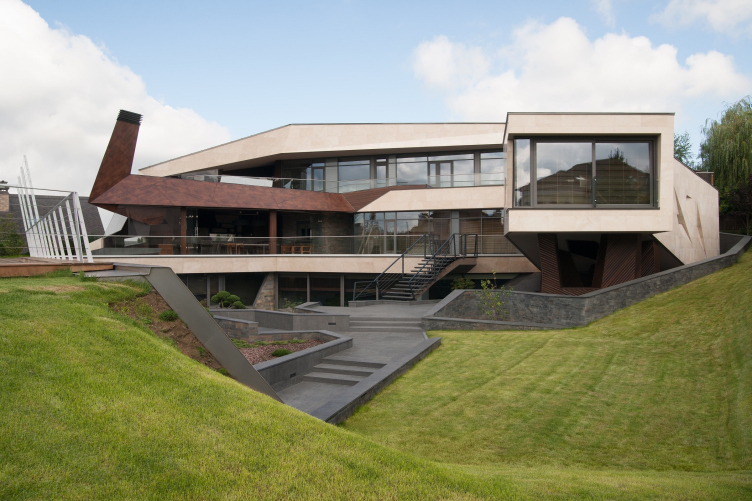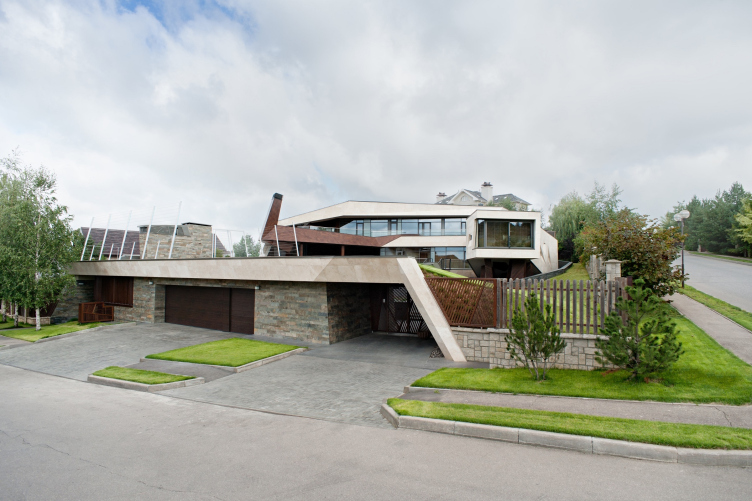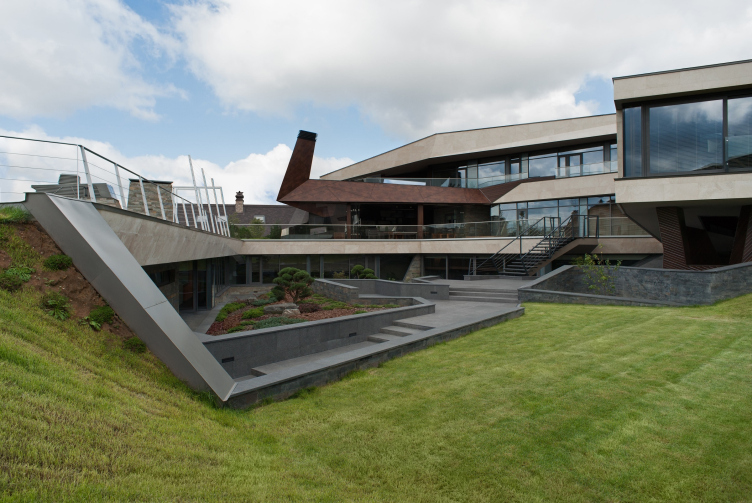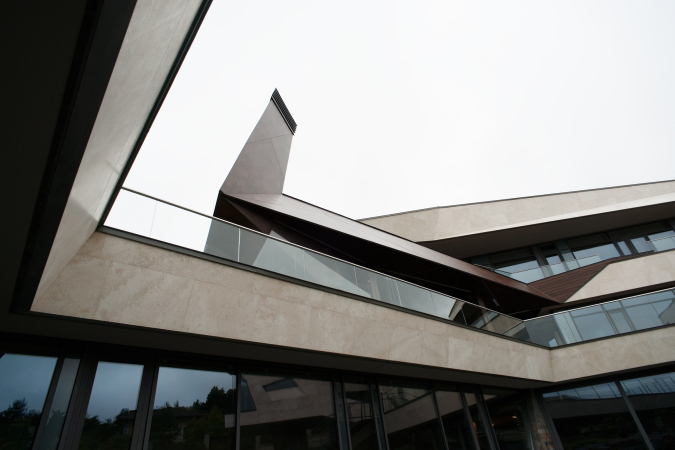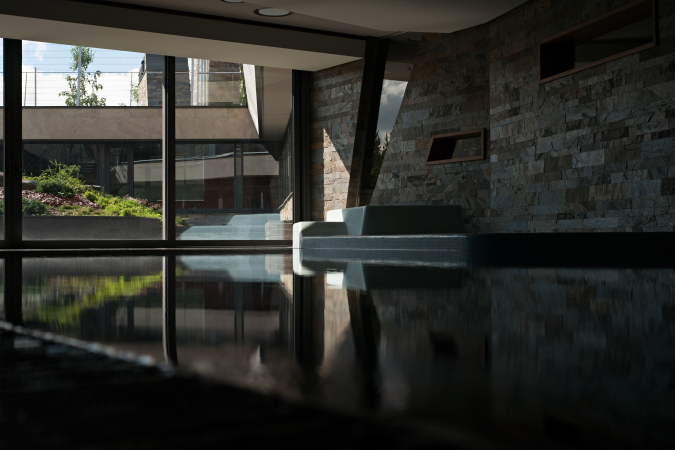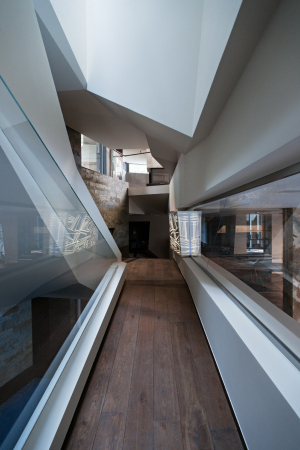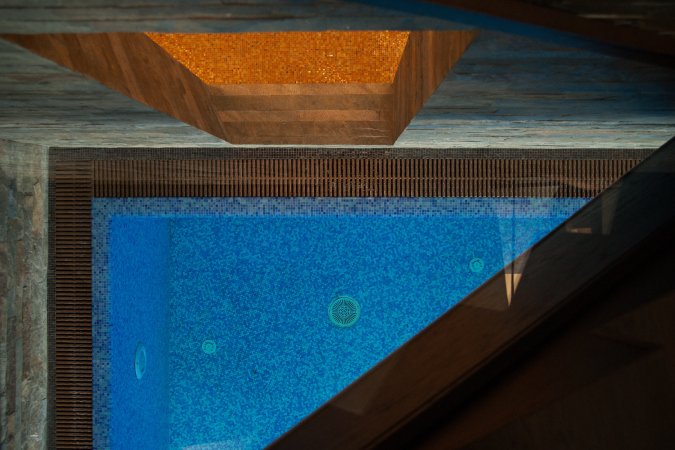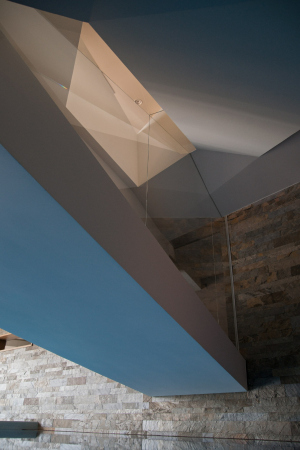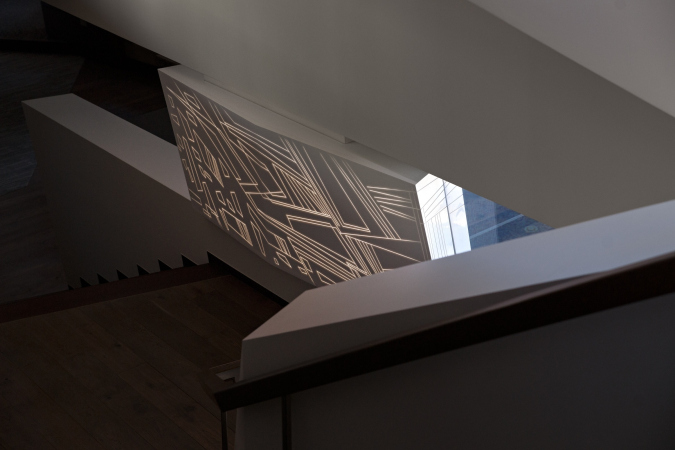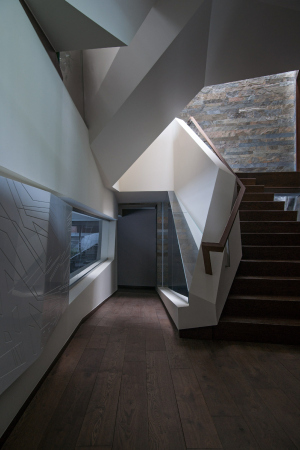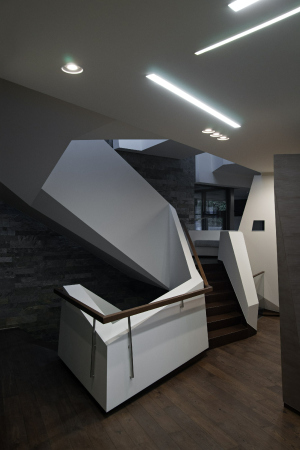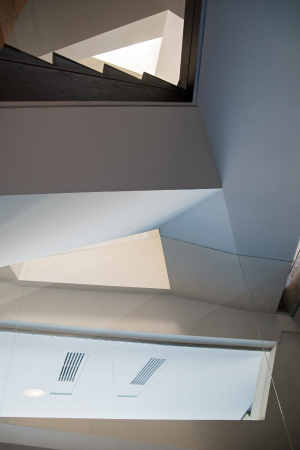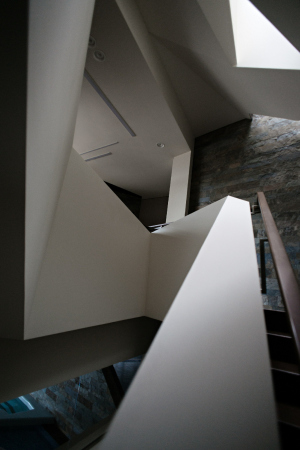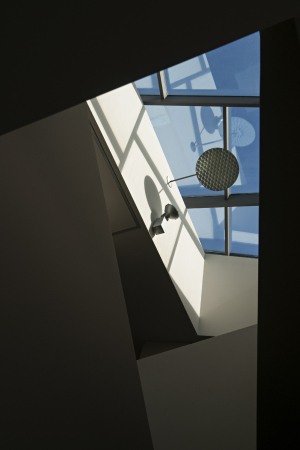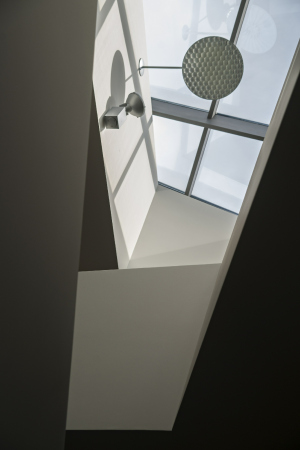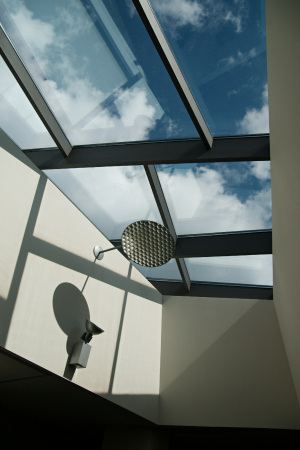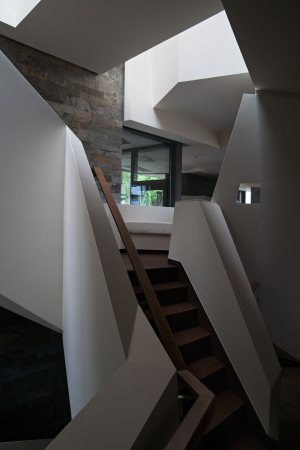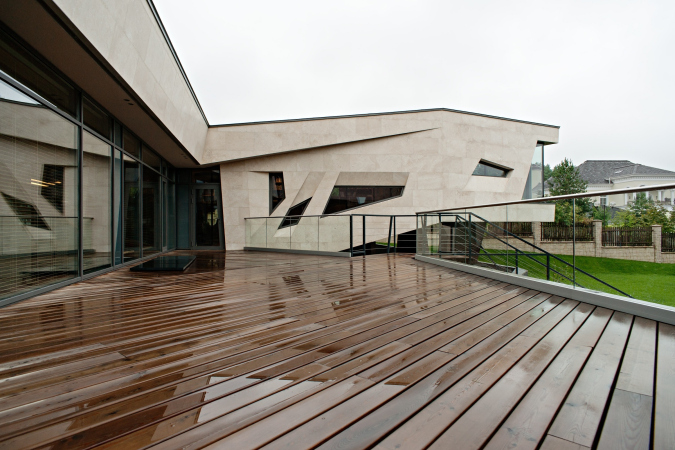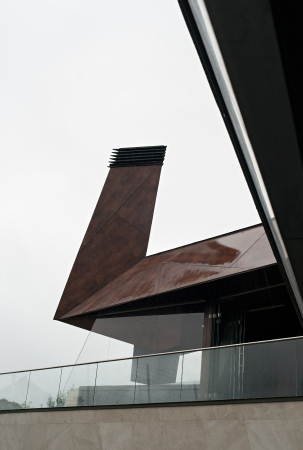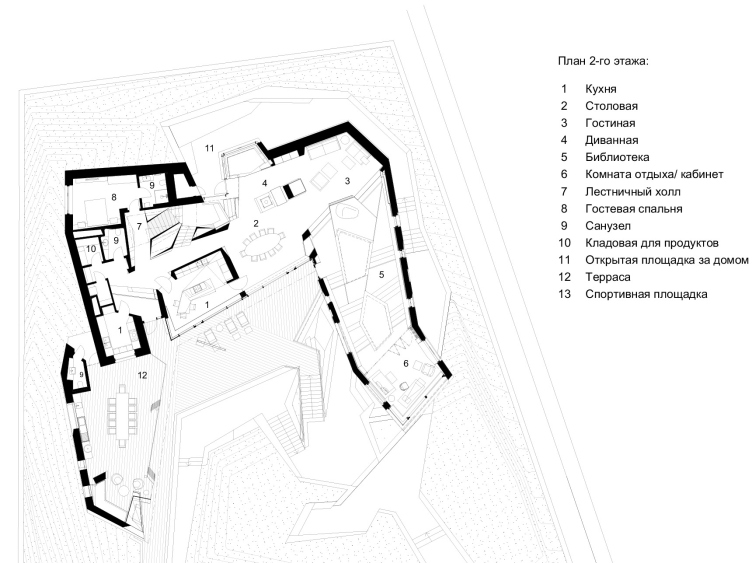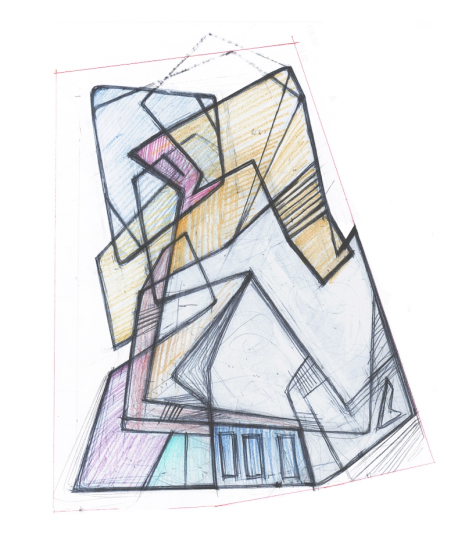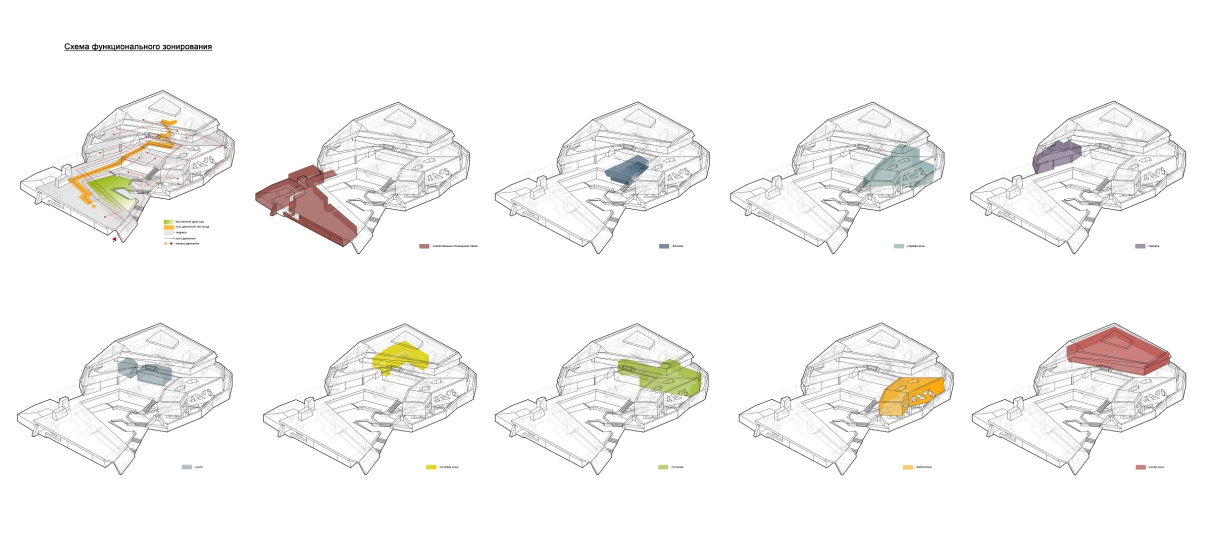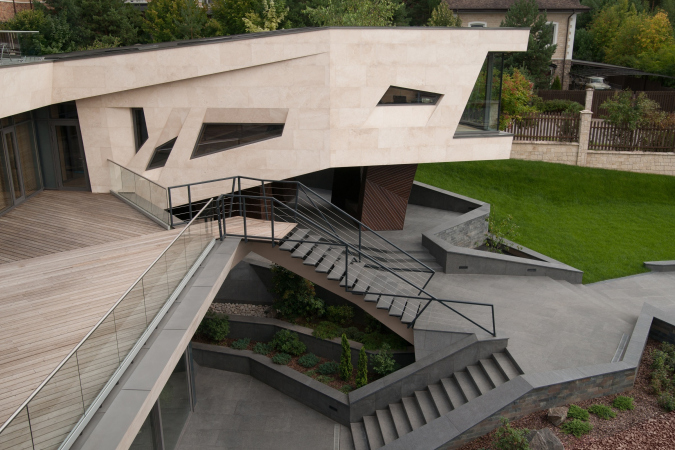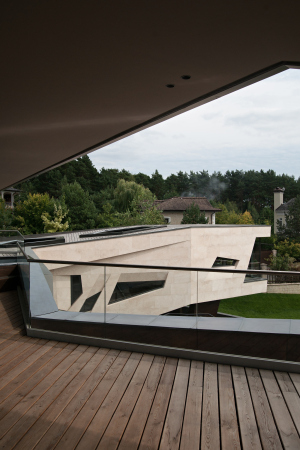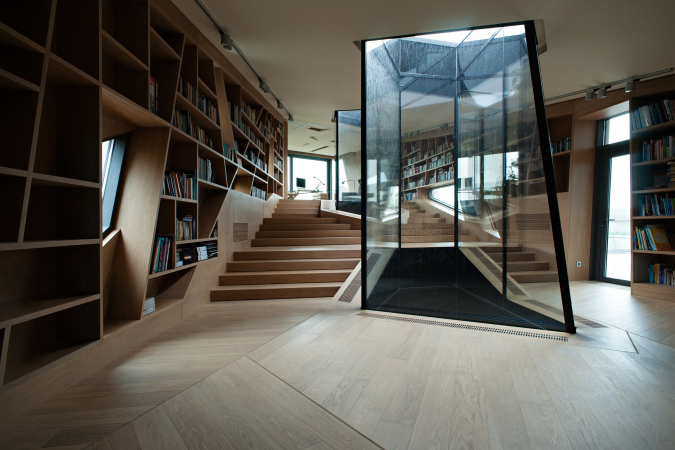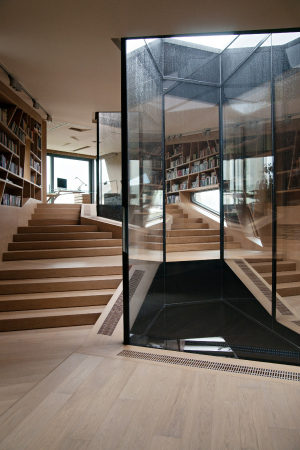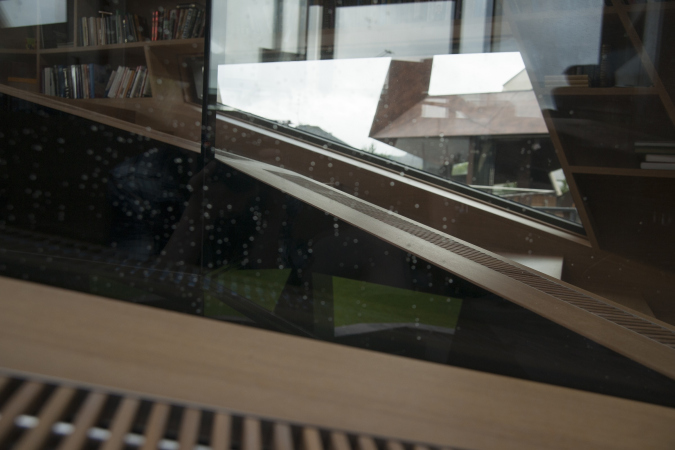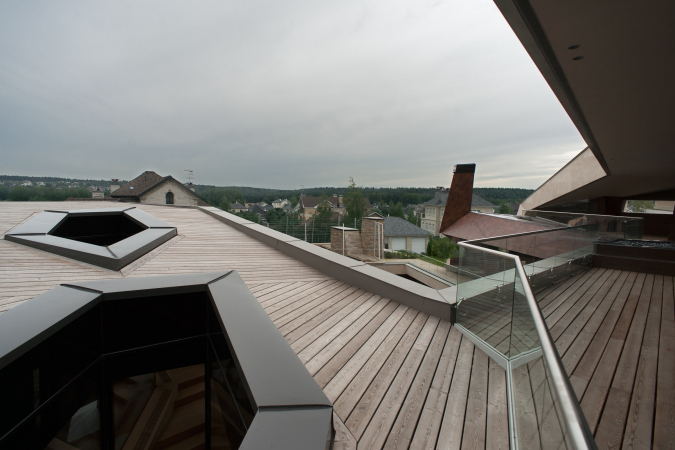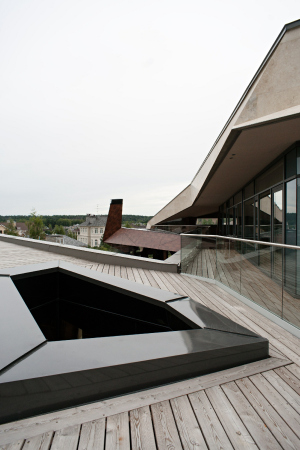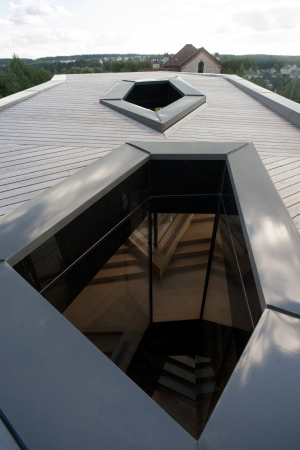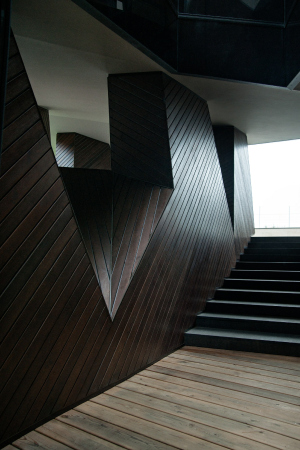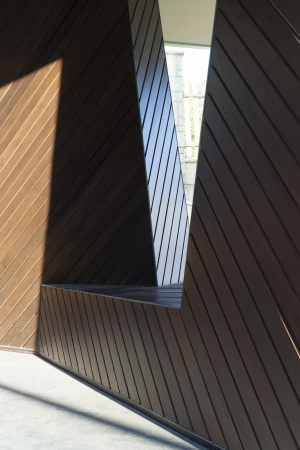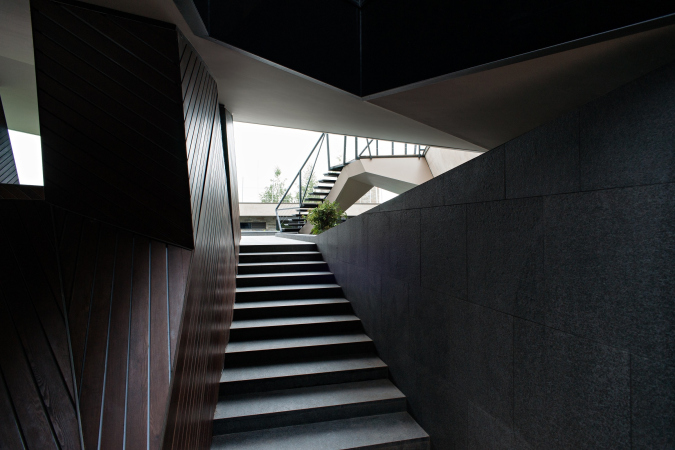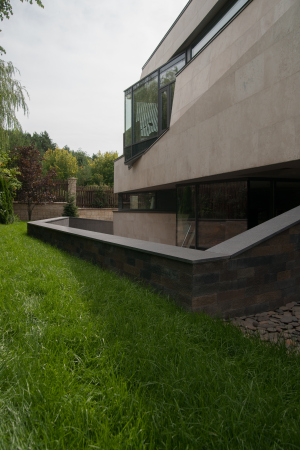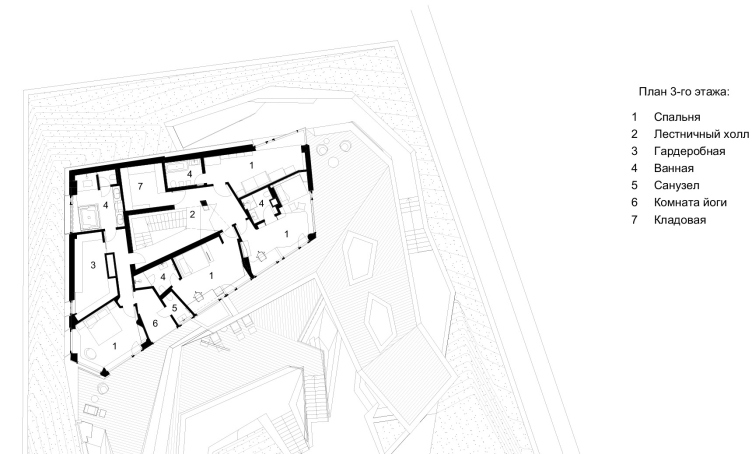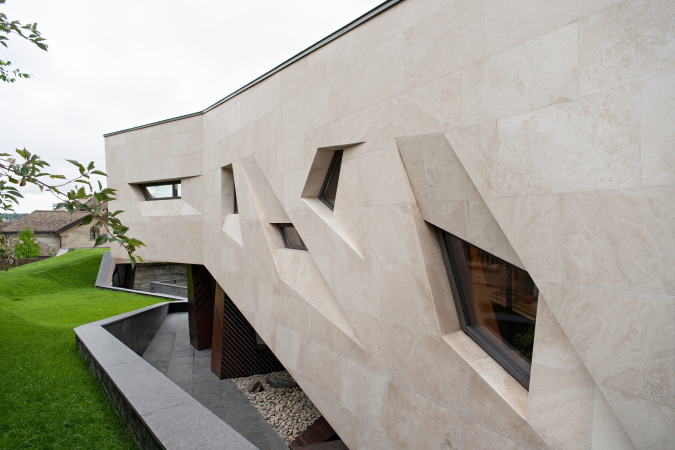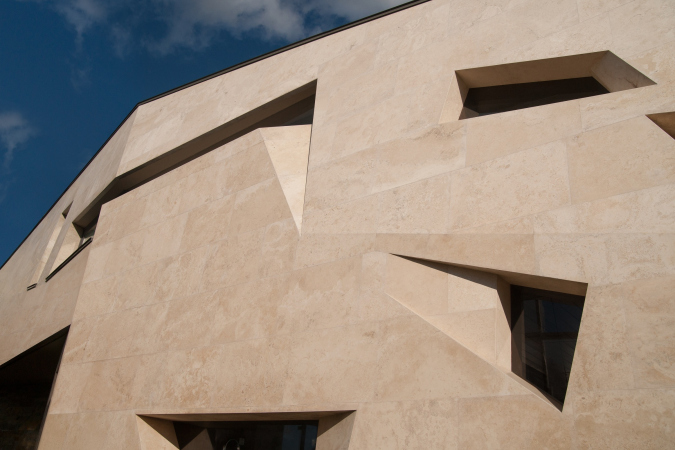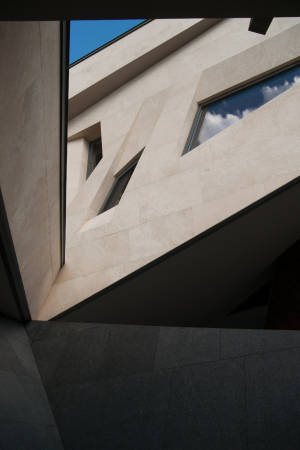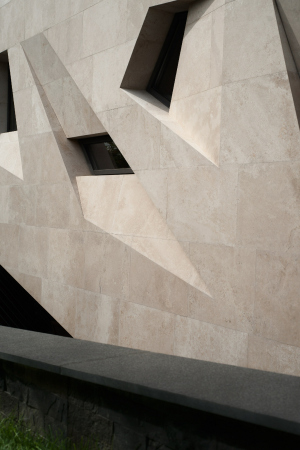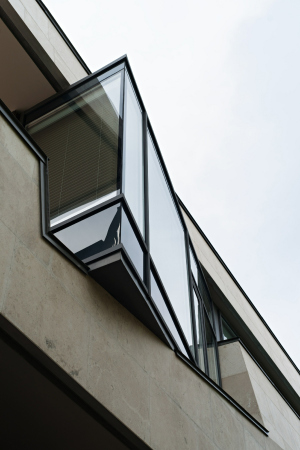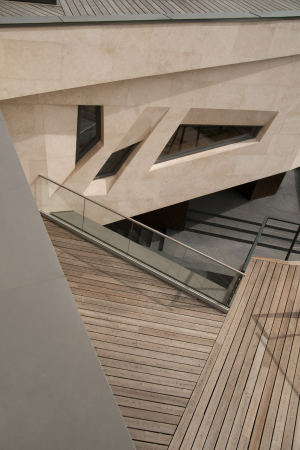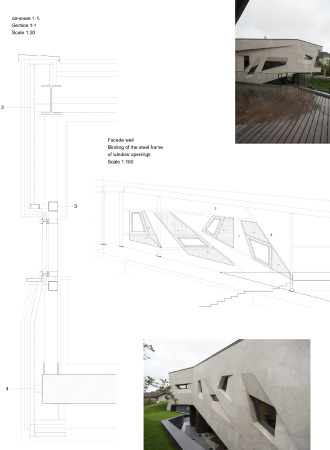The house with a total area of about 1200 square meters is situated in a township not far away from Moscow, on a small 0.26-hectare land site with a height difference about 4.5 meters from north to south. All around it, on similar small land plots, stand the private residences that are a habitual sight for the Moscow area – two or three stories high, large and expensive looking, placed rather close to one another: a house, a small land plot around it, a fence, and so on.
This villa, carefully designed and built by Levon Airapetov and Valeria Preobrazhenskaya, is radically different from all of its neighbors. To me, the house seems to look like a lizard lying down on a slope around a small yard with its tail stretching along the entrance, its side buried in the north slope, and its head slightly raised on short paws, enjoying the scenery – beyond the border of the land site, the slop goes down still lower, while in the perspective, on the opposite hill, a church is peeking from behind the trees.
The “Spring” house
Copyright: Photograph © Gleb Leonov | TOTEMENT/PAPER
The “Spring” house
Copyright: Photograph © Gleb Leonov | TOTEMENT/PAPER
There are two main things that set this building apart from its neighbors: first of all, the last thing it does is “stick out” towering above its neighbors – on the contrary, it “prowls” on the ground, without obscuring any views. The architects are sharing that getting the neighbors’ approvals for the proportions of the villa had a serious impact on the entire project – they ultimately had to diminish the height of the top third floor, which in the original version towered above the second tier on a glass “neck” like yet another “head” – the “neck” was removed, and the third floor dropped down on top of the second, which made the house cling to the ground still more, even though that was not the original idea. But then again, I would say that this doesn’t make things any worse: this being at one with the landscape, and “growing up from the slope” is one of the immanent qualities of this project, and now it is better emphasized; in addition, the house used to have two heads, and now, thank God, only one. But then again, it has several hearts, but we’ll get to it later on.
The second difference from the neighbors is emphasized by Levon Airapetov as the main one. Instead of standing in the middle of the land plot (which would have been the obvious choice), the house groups itself around an inner yard, stretching along the borders, even if stepping back the necessary few meters from the edge. Essentially, this is the principle of the Ancient Roman villa – the impluvium and atrium on the inside, surrounded by residential and other premises. However, Levon Airapetov, an architect who is very much into Far East culture, gives an example of a Japanese building that is organized in a similar way – around the yard. We will not contradict the author in this case – OK, let it be an oriental dragon instead of a lizard. This creature is dangerous, with a personality of its own, but when at rest, the motion not kinetic but only potential, coiled inside and ready to unwind – the TOTEMENT architects are emphasizing this image, likening their project to a spring. Meanwhile, as is often the case with architecture, the potential motion develops into a real wealth of perception as one starts moving around the house. The house is coiled in such a way that the impressions are constantly shifting, uncovering various space narratives and viewing angles – upwards and sideways. “You will have a hard time moving from such house to a city flat – Valeria Preobrazhenskaya says – It’s got so much space about it, both on the outside and in terms of inner perspectives”.
The “Spring” house
Copyright: Photograph © Gleb Leonov | TOTEMENT/PAPER
So! The entrance to the house and the driving entrance to the garage are situated on the south side. Here, along the street, from east to west, the slope is gradually getting higher – a green roof stretches over the fence door, the garage gate, and further on to the west – over the staff rooms, where there is a small covered recreation yard organized amidst the bedrooms. Between these premises and the garage entrance there is a small classroom; it can be accessed both from the inside and directly from the outside.
The “Spring” house. Plan of the 1st floor
Copyright: Photograph © Gleb Leonov | TOTEMENT/PAPER
On the roof of the entrance group, there is an open-air sports field, and there is an open overpass leading to the second-floor terrace with a barbecue spot. In the eastern part, where the “tail” gradually comes to naught, the fence starts – originally, it was conceived in the spirit of the house as being diagonal and openwork, yet what survived from this idea is only a small fragment – the lath fence with small pillars in the remaining part falls in with the general rules of the township.
The “tail” protects the inner yard from the street glances – on the east side it is also fenced off with a small bund wall and therefore is 100% private. Passing through the little entrance door, we find ourselves in the yard, and then, descending a few stairs, to the swimming pool. The yard and the pool became the two centers, two nuclei of the house, divided and at the same time connected by lintel of a glass wall.
The “Spring” house
Copyright: Photograph © Gleb Leonov | TOTEMENT/PAPER
Due to the fact that Russia is generally a cold country, the path that runs through the yard, as well as the overpass, are chiefly meant to be used in the summertime; from the garage, the main entrance leads to the left, down the yard and along the gallery, whose right wall is made of glass, overlooking the yard, further on, there is a stone wall with loopholes overlooking the swimming pool, then we turn right and find ourselves standing on a bridge thrown over the (due to the fact that the pool is actually a “wet” zone, it is cornered with glass, but without any joints, and all the views are visible).
Anyway, the bridge passes over the swimming pool, and soon behind it the main staircase starts that connects the three floors: a spacious billiard room down below, the public second floor, and the private third. The staircase – a white spiral, marked by jagged slanting planes – is crowned by a glass lamplight that encases it into a column of light, a softly glowing “core” of the entire building. It is here that we see the beginning of the potential motion – between the swimming pool and the glass of the lamplight, where the conceptual communication nucleus is coiled like a spring and is hung between the water and the sky. Emphasizing the importance of this place – the crossroads between the longitudinal horizontal path and the vertical axis – the architects placed at the foot of the staircase a semblance of a “cornerstone” made of glowing Corian with a pattern of large-stroke diagonals and zigzags that symbolize the complexity of the space of the house. Levon Airapetov himself calls this the “heart” of the house, even though he at once corrects himself by saying that this house, obviously, has more than just one.
However, it’s not just about the structure of the motion. Placing a swimming pool INSIDE of a house, making the entrance route run literally through it, by the bridge and over the water is a really unconventional approach by the standards of a modern house: nowadays, in the overwhelming majority of the projects, the architects place the “wet zone” of the spa somewhere in the far corner of the land site. In our instance, however, in addition to the emotional meaning of changing of impressions and the unexpected nature of the architectural solution, there is also a typological story. While Levon Airapetov himself refers his creation to the Far East tradition, it still seems to me that the architects were able, for some reason, to revive the ancient typology of the European villa, and first of all, of the Ancient Roman domus organized around the impluvium, a yard with a pool for collecting rainwater. This project is, of course, not that simple and straightforward: the swimming pool here is rather the piscina because it has nothing to do with collecting rainwater. And the staircase that “intrudes” into the system of the “pool” yard (due to the fact that it springs up immediately behind the bridge) is more reminiscent of the European palace (or its “younger brother”, the city hotel), which, starting from the Gothic epoch or even earlier, would be designed and built around the yard, with one of its corners boasting a spiral staircase, usually very beautiful. Mind, I am not speaking here about verbatim replication or any revival of the pre-classic house typology, Roman or Gothic – rather, I am speaking about the fact that through the creative impulse of TOTEMENT “grows through” a certain house pattern, just like antiquity shows through in Brodsky’s poetry – structurally, without any deliberate stylization, even though not without a fair share of nostalgia for the strong visions from the other side.
Back to the staircase, though! Not only does it provide access to all of the floors, but it also sports a few extra inclusions: between the first and the second floor, there is a small sofa; next to it, there is a small window cut through in the partition; a little further on (on the second floor), there is a bay window with a sofa of a slightly bigger size, which essentially is already part of the living room.
The second floor is divided roughly in half into a living room and a summer kitchen with an open air barbecue spot, whose large chimney, covered in brownish “copper” FunderMax façade panels, is plainly visible from the yard and bleeds into the awning of a large terrace.
In the center of this floor there is a kitchen – the second nucleus of the house after the staircase. In the northwest corner, there is a guest bedroom, a spacious winter living room with yet another fireplace and an aquarium next to it occupying the entire eastern part of the second floor. The second floor is a public one, i.e. designed for socialization; it is essentially yet another version of an open space, parts of which bleed into one another, being not divided but tactfully zoned. It is visually permeable to the sunlight as well: from south (where the panoramic glass of the terrace is) to north (where the aforementioned bay window is with a davenport stretching along the glass).
The “Spring” house. Plan of the 2nd floor
Copyright: Photograph © Gleb Leonov | TOTEMENT/PAPER
The permeability of the house for the gaze directed outside from within, as well as for the rays of sunlight is something that was crucially important for the architects – they even drew quite clear schemes demonstrating the interaction of these rays, and the jigsaw puzzle of all the rooms of the house. There are great views opening up both upwards and sideways, so there is very little chance of getting claustrophobic here.
Here, in the east part of the winter living room, starts the path to the library and the master’s study – the “head” set on a long neck, turned with its side end stained glass to the panorama with the church. The library is organized as a broad corridor; it grows slightly narrower and ascends southward with a few flights of flat stairs of wooden floor. All of the walls are occupied by bookshelves, the contours of the windows being inscribed into their sophisticated diagonal pattern.
“You can take a book off the shelf, sit down anywhere you choose to, for example, on the stair by the window, and start reading it” – the architects say. However, that’s not all there is to it. This “corridor” library is pierced by two glass wells – two “glasses” completely open at the top and bottom, and completely closed from the library. Sitting on the stairs, one can also watch snow or rain through these transparent “caverns”.
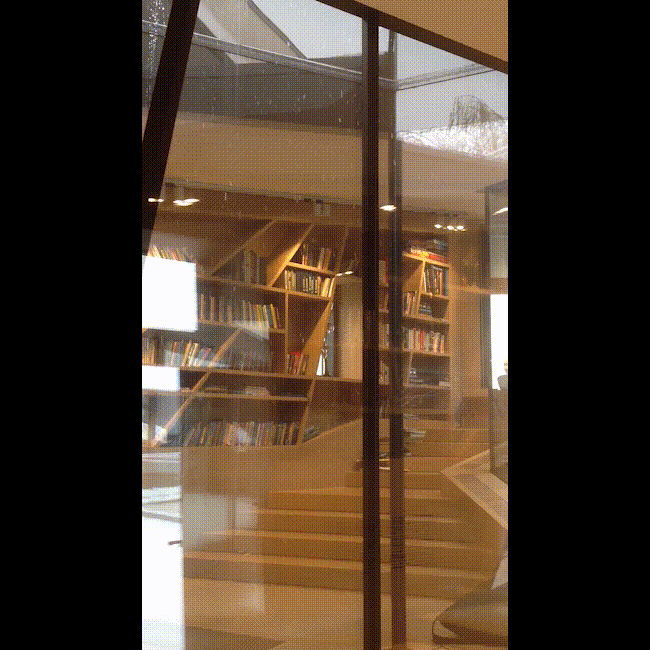
Looking at these “glasses”, you again involuntarily start thinking about the antique campluvium: an open roof, through which rainwater would come pouring in. Here you can also remember about a small school with an entrance from the outside: what else can it be if not a taberna? And as for the corridor of the library – is it not the wooden Roman gallery, aka tablinum? The only significant difference is that the atrium, which is supposed to be spreading around the hearth, got “split” into two spaces – next to the summer and the winter fireplaces... But then again, I will repeat myself here, all of these associations are rather conditional, and you can just as well see parallels here not only with a Roman but with any other European home (yes, a big one, too, but 1200 square meters is just the perfect size for comparison). Rather, one wants to emphasize that specialized elements of space in this house are much more numerous than in a regular modern one, however large.
Just as the vertical axis of the staircase, the space of the library is the most intriguing in this house and full of emotion. The concrete pillars that support the library can be seen through the skylights; on the level of the first floor they are covered with wooden planks; the joints are backlit with LEDs at night, which creates a bright striped pattern and strengthens the effect of the study “head” levitating. One can also get to the foot of the first tier by exiting from the balcony of the second floor and walking alongside the house – the place generally has a lot of alternative routes in it, which duplicate and even shortcut the main paths.
The third floor contains the family bedrooms, the parents and children sleeping on two different halves. In addition, the parents’ balcony with a flowerbed, which ensures extra privacy. The third children’s room, the bedroom of the youngest child, is turned north but is also equipped with a triangular bay window that catches the light and allows you to peek a little beyond the surface of the wall.
The “Spring” house: plan of the 3rd floor
Copyright: Photograph © Gleb Leonov | TOTEMENT/PAPER
The “Spring” house: view from the north
Copyright: Photograph © Gleb Leonov | TOTEMENT/PAPER
Anyway, the house, rather large, curved up in a ball within the confines of the land plot, propping up the slope with one of its sides, is subjected to the “from the inside out” principle: the architects formed conceptual and emotional “nuclei” and connected them together, tying them into a “spring”, also taking care about the energy outlets “to the world outside”: these are, for example, the side end stained glass of the library – the “head” or the “tail” of the fireplace chimney. True, there are right angles here but they do not play any significant part – everything is sophisticated; the space and the shapes are flowing, only slightly creaking at the bends, forming a giant volumetric origami.
The form not just plays here the main part, it is not just “unusual and cutting-edge” – it organizes the emotions inside and outside, showing through in accordance with its own logic. It must be precise without being excessive, and it cannot be too pristine because it has to be flamboyant at the same time. This task of making the form come alive, like an animal ready to leap, full of potential motion – is something that the architects have long since mastered, time after time honing and perfecting this idea. You need to learn to handle this form like a wild animal tamer learns to tame a wild animal, not to mention dragons – without stepping over the edge of what’s motivated, yet keeping the whole thing “alive and breathing” nonetheless. Which is, basically, what the architect’s work is all about, and it’s just great that in our days of efficient management there are still people out there who set such goals for themselves.
The implementation of such a project cannot be easy even in Europe, much less in Russia, and, strictly speaking, if you undertake to handle such a task, you need to be prepared to face difficulties, to redo something all over again, and to make on-the-spot corrections. For example, at the outset of the project, the architects were planning to cover the façades with white stucco but then they made a decision to coat it in Jurassic plaster, and on the subsystem, too, the façade being of the ventilated type, with ventilation outlets visible in the top and bottom ends of the walls. However, the house is basically meant to produce an effect of a sculptural monolith, and, in order to avoid the telltale joints, it was decided to glue the stone slabs upon aquapanels, installed, in turn, over the hear insulation material. The architects carefully selected the slabs in accordance with their color, making sure that the hints are as inconspicuous as possible. A lot of detailed drafts of the façades were made, including for the windows of the library.
In a word, a project like this requires a fair bit of painstaking work, both pragmatic, with the drafts and on the construction site, and conceptual, when you deal with such an agile form, you need to address lots of details, much more than in a “regular” house. What is also important is the fact that the architects work their ideas to perfection, ground their fantasy on real needs analysis and then implement it without any significant simplifications. Which, obviously, can also be considered to be a variety of Zen practice. What we’re ultimately getting is a cutting-adage version of the Ancient Roman domus. Well, or the Far East dragon who is reclining to contemplate the idyllic mid-Russian scenery.




